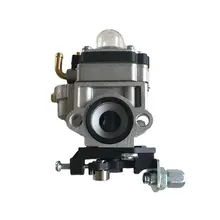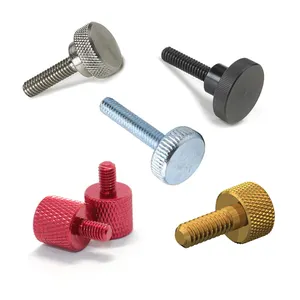A knob screw is an indispensable fastener found ubiquitously across a multitude of sectors and applications. Its defining feature is a head crafted for effortless manual manipulation, enabling swift assembly and calibration sans specialized implements. Available in an array of materials, finishes, and configurations, knob screws serve an extensive range of purposes, from securing components in industrial apparatus to assembling domestic furnishings.
Types and Characteristics of Knob Screws
Variety abounds among knob screws, with options like thumb screws, wing screws, and knurled screws each presenting distinct advantages. Thumb screws are notable for their prominent, gently domed heads that facilitate manual operation. Wing screws, with their dual flat extensions, offer superior grip, proving advantageous in scenarios necessitating regular tweaking. Knurled screws, with their textured heads, afford additional traction in slick conditions. This assortment ensures a knob screw is on hand for virtually any scenario where hand adjustments are requisite.
Structure and Operation of Knob Screws
The architecture of a knob screw is elegantly straightforward, comprising a manually operable head atop a threaded shaft that secures components. The head may feature grooves or depressions to augment grip. Rotation of the screw drives the shaft linearly into or out of the material, ensuring a steadfast connection. This simplicity is vital in environments where frequent modifications or maintenance are the norms.
Materials and Properties
Material selection for knob screws is pivotal, dictated by the specific demands of their application. Stainless steel is lauded for its robustness and resistance to corrosion, ideal for use in moist or outdoor settings. Carbon steel provides an economical alternative with respectable tensile strength for general applications. Aluminum screws, being light and rustproof, are apt for the aerospace or electronics sectors. Plastics such as Bakelite offer electrical insulation, whereas PP (Polypropylene) is resistant to chemicals, making it suitable for the chemical processing industry. Each material is selected for its inherent merits, ensuring the knob screw's peak performance in its intended role.
Business Usages and Applications
In the commercial realm, knob screws are vital. They facilitate on-the-fly adjustments in manufacturing settings without disrupting production. In the realm of furniture design, they empower consumers to assemble and modify pieces with minimal effort. Within the technology sector, they secure panels and apparatus necessitating routine maintenance. These screws not only streamline workflows but also amplify product functionality and user accessibility, thereby generating substantial business value.
Functions and Tasks
The fundamental role of a knob screw is to affix components while permitting hand-driven adjustability. They are engineered to be hand-tightened or loosened, simplifying tasks such as affixing a camera to a tripod, modifying the elevation of an office chair, or fastening a lighting fixture. The tool-free nature of knob screws renders them a practical choice in diverse contexts.
Features and Unique Selling Points
Knob screws are characterized by their head design, which can be tailored to complement the aesthetic of the product they integrate with. The variety of finishes on offer, ranging from matte to lustrous, ensures a cohesive appearance. Their ease of use without the necessity for additional tools is a notable advantage, diminishing the need for supplementary equipment and instruction.
Benefits and Positive Outcomes
The advantages of employing knob screws are numerous. They secure while enabling expedient adjustments, curtailing downtime in industrial environments. Their user-friendliness promotes operational efficiency and can contribute to the ergonomic refinement of products, culminating in an enhanced user experience. Moreover, the reusability of these screws aids in cost reduction and environmental conservation.
How to Use and Operate Knob Screws
Utilizing knob screws is a straightforward affair: select the screw that matches the material and task at hand, align it with the threaded aperture, and rotate the head clockwise to tighten or anticlockwise to loosen. While no tools are necessary, some screws may include a slot for a screwdriver or a hex socket for added leverage when tightening.
How to Choose the Right Knob Screw
Selecting the appropriate knob screw entails evaluating the application, compatibility with the material, environmental conditions, and the frequency of adjustments. Consider the load it must support, the environment it will operate in—be it corrosive, damp, or high-temperature—and the extent of manual adjustment required. Aligning these considerations with the knob screw's attributes guarantees optimal functionality.
How to Clean and Maintain Knob Screws
Maintenance of knob screws typically involves a simple wipe-down with a clean, dry cloth. For screws exposed to corrosive substances or the elements, a more rigorous cleanse with suitable solvents may be warranted. Routine upkeep includes inspecting for wear and applying a light lubricant to the threads if they stiffen.
How to Install Knob Screws
Installation is a matter of positioning the screw in the threaded hole and twisting the head manually. For delicate equipment, take care not to over-tighten to prevent damage. When adjusting tension, such as on a musical instrument, make incremental turns and frequently test the tension.
Target Audience and Meeting Needs
Knob screws are aimed at professionals in manufacturing, furniture design, and maintenance, as well as at hobbyists and DIY aficionados. These fasteners address the demand for a secure yet adjustable fastening solution that can be manipulated by hand, catering to preferences for convenience and efficiency.
How does the head type of a knob screw affect its application?
The head type of a knob screw, be it oval, round head, or pan head, influences its application by dictating the distribution of force upon tightening and the ease of manual adjustment. For example, a round head offers a solid grip for hand-tightening, making it apt for settings where frequent adjustments are commonplace. Thus, the selection of the head type is a crucial factor in the design and application of knob screws.
What are the considerations for selecting the right knob screw for my business?
In choosing the ideal knob screw for your enterprise, factors such as material, head type, finish, and compliance with standards must be weighed. The operational environment, the nature of adjustments required, and the product's aesthetic needs are all vital considerations. Moreover, ensuring the screw's compatibility with the materials it will join is critical for a secure and enduring bond.
How can I ensure the longevity and maintenance of knob screws in my applications?
To guarantee the durability and upkeep of knob screws, opt for materials and finishes suited to the operational environment. Periodic checks for wear or corrosion can preempt issues. When needed, clean with the correct solutions and apply lubricants to maintain adjustability and avert seizing, thus prolonging the service life of the knob screws in any application.











































 浙公网安备 33010002000092号
浙公网安备 33010002000092号 浙B2-20120091-4
浙B2-20120091-4